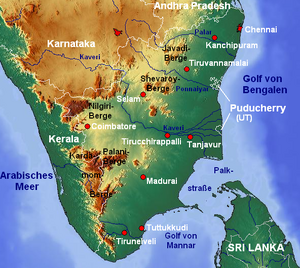Korkai
| Author:Laxman Burdak, IFS (R) |

Korkai (कोरकई) is a small village in the Srivaikuntam taluk of Tutukuddi district in Tamil Nadu, India. It was called Pandya-Kavada in the Kapatapuram in Kalithogai.
Variants
- Korkai/Korakai (कोरकई) (जिला तिन्नावेली, केरल) (AS, p.236)
- Kolkhai (Ptolemy)
- Kokou (कोकोऊ) (Tamil lit.)
- Koragaha (कोरगाह) (Sanskrit Lit.)
Location
It is situated about 3 km north of the Tamraparni River and about 6 km from the shore of Bay of Bengal.
Origin
Jat clans
History
Korkai was the capital, principal center of trade and important port of the Early Pandyan Kingdom. At that time, it was located on the banks of the Tamraparni River and at the sea coast, forming a natural harbour. Due to excessive sedimentation, the sea has receded about 6 km in the past 2000 years, leaving Korkai well inland today.
The famous urn burial site, Adichanallur, is located about 15 km. from Korkai.
In ancient times, Korkai was a well known center of pearl fishery; it is mentioned often in the Sangam literature and in classical western literature. Ptolemy refers to the place as Kolkhai and says that it was an emporium. The Periplus says that the Pandyan kingdom extended from Comari towards the north, including Korkai, where the pearl fisheries were.[1]
The 2000-year-old 'Vanni' tree is in Korkai.
Correct identification of Korkai by archaeological excavations came in 1838. The findings of megalithic burial urns at Korkai indicates that it was fairly well populated during megalithic times. Carbon dating of the artifacts in the area indicates an age of 785 BC. The finds of black and red pottery ware with old Tamil Brahmi scripts (two to four letters in a line or two), apart from drawn graffiti of the sun, fish, bow and arrow have been dated to a period between 3rd century BC and 2nd century AD. The occurrence of Roman ware, and rouletted ware indicates external links. Archeologists have found ruins of chunku cutting factories, centres for split opening of pearl oysters at the site.
Palaeo-channels traced from the satellite imagery scenes all around Korkai indicate that the Tamraparani river has shifted its course progressively east and south and earlier it had mixed with sea near Thoothukudi. Interpretation of satellite imagery indicates that in the 1st and 2nd century CE, the Tamiraparani river might have flowed towards northeast from Eral, parallel to the coast and joined the sea south of Thoothukudi. Korampallam tank, Peykulam, and Arumugamangalam tank might be the relicts of palaeo channel of the Tamiraparani river. Within a short span of nearly 2000 years, now Korkai is nearly 6 Kilometers away from Bay of Bengal and 3 Kilometers north of Tamraparni, which was once a port and in the banks of the Tamirabarani and Thoothukudi has no river.[2]
कोरकाई
विजयेन्द्र कुमार माथुर[3] ने लेख किया है ...कोरकाई (AS, p.236) केरल के तिरुनेल्वेलि ज़िले में ताम्रपर्णी नदी के तट पर स्थित प्राचीन काल में एक प्रसिद्ध नगर था। बाद की शतियों में यह बड़ा और समृद्धिशाली बन्दरगाह बना। कोरकाई पांड्यों की प्राचीन राजधानी हुआ करती थी। तमिल ग्रंथों में इसे 'कोकोऊ' और संस्कृत ग्रंथों में 'कोरगाह' कहा गया है। पाण्ड्य नरेशों के समय मोतियों और शंखों के व्यापार के लिए कोरकाई प्रसिद्ध था। कोरकई बंदरगाह द्वारा दक्षिण भारत का रोम के साम्राज्य से भारी व्यापार होता था। यूनानियों ने भी इस स्थान का उल्लेख कोरकई नाम से ही किया है। पांड्य शासन काल में मोतियों और शंखों के व्यापार का केन्द्र भी इस नगर में था। इनसे पांड्य नरेशों को विशेष आय होती थी। दक्षिण भारत की अनुश्रुतियों के अनुसार पांड्य, चेर और चोल राज्यों के संस्थापक तीन भाई यहीं के निवासी थे। पांड्यकाल में राजधानी मदुरा में थी, फिर भी राज्य का उत्तराधिकारी राजकुमार कोरकई में ही रहता था, क्योंकि इस नगर का व्यापारिक महत्व बहुत अधिक था। पांड्य नरेशों का राज्य-चिन्ह 'परशु' और हाथी था। आजकल कोरकई ताम्रपर्णी नदी पर एक छोटा-सा ग्राम मात्र है। कोरकई बंदरगाह मुहाने के रेत से भर जाने के कारण बेकार हो गया और धीरे-धीरे सुदूर दक्षिण का व्यापार नए बंदरगाह 'कायल' में केन्द्रित हो गया।
External links
References
- ↑ Majeed, A. Abdul (March – June 1987). "A note on Korkai Excavations". Tamil Civilization. Tamil University, Thanjavur. 5 (1–2): 73–77.
- ↑ Reconstruction of the ancient port of Korkai, Thoothukudi district (PDF
- ↑ Aitihasik Sthanavali by Vijayendra Kumar Mathur, p.236

